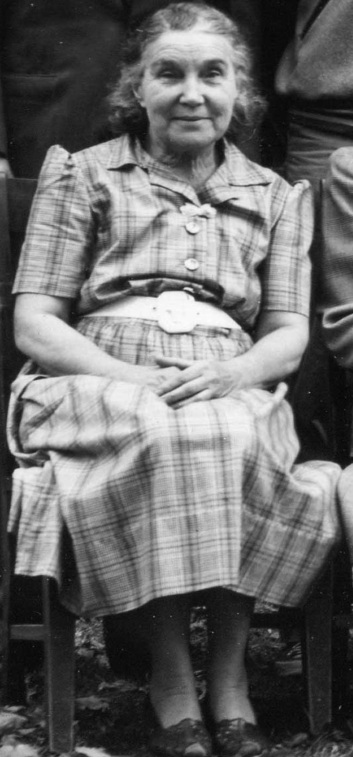A recollection by Gerry Holtzman
Whenever I think of her, my mind fills first with strong tones of black and gray, punctuated by brief traces of white. Out of those somber shadows, a tiny figure slowly emerges and I see Jennie Cogan once more.
She wears a severe black dress with some sort of simple white neckpiece. Her coarse grey hair is pulled back into a proper bun. There is no jewelry or any sort of decoration on her dress or on her person. Not a ring or pin or even a watch.
Her expression is equally serious. Accentuated by wrinkles, framed by steel-rimmed spectacles and unrelieved by makeup, it is a face of a woman who brooks no nonsense—the face of a woman who has a job to do and who is intent on doing it.

Holding an open book, she stands in front of a room-length, dusty blackboard which is covered with rows of precisely regimented phrases. Not quite five feet tall and shorter than all of her students, this iron-willed and determined woman is reading aloud. She is reading poetry to her 14 seventh graders.
My mind’s eye widens and I see myself in the row by the window. Although many of my classmates appear indifferent, I sit enthralled. The poem she is reading is Kipling’s “Danny Deever.” In fact, whenever I think of Miss Cogan, she’s always reading “Danny Deever.”
I can no longer hear her voice but I can clearly hear the words—I memorized them, not because we had to but because I fell in love with the sounds of those words, the pictures they evoked and the way the rhymes bounced off each other
“For they’re hangin Danny Deever, you
can ‘ear the Dead March play.
The regiment’s in ‘ollow square—they’re
Hangin him to-day.”
As a 12 year old, growing up in the tiny upstate village of Amenia (pop. 987, alt . 573), I wasn’t quite sure where India was or why Danny had “shot a comrade sleepin’” but I was fascinated by the rhythm and the incongruity of:
What makes the rear rank breathe so ‘ard!”
Said Files-on-Parade –
It’s bitter cold, it’s bitter cold “ the Color-
Sargeant said.
What makes that front-rank man fall down?”
Says Files-on-Parade.
“A touch of sun, a touch of sun,” the Color- Sergeant said.
She pronounced “said” so that it rhymed with “parade.” It became “the color-Sergeant sayed”. I don’t think Kipling intended those two words to rhyme so precisely but, to this day, whenever I read or recite that poem, I still find myself pronouncing “said” the way Miss Cogan did.
And she was, of course, Miss Cogan. Although her spinsterhood was an established fact, none of us in seventh grade knew where she actually lived. George Clinton claimed that she had a room across the street from the school in Mrs. Foley’s attic. But George was only in sixth grade and had been known to exaggerate in other situations, so most of us dismissed this as unreliable gossip. We preferred the more tantalizing theory that she lived somewhere in the school building, the most likely location being in the basement next to the furnace room. We made up some grand stories about her life down in that dingy basement and, being typical seventh graders, added some sex interest by including tales of wild assignations in the coal bin with Red O’Connor, the ancient school janitor.
In all honesty, during the eleven years I lived in Amenia, I can’t recall ever seeing Jennie Cogan anywhere but in her seventh grade classroom. Where she lived was, in fact, unimportant; her real home was in that classroom.
Like all elementary teachers in Amenia, she taught two grades which were both contained in a single classroom. The seventh grade sat on the window side of the room, the eighth grade sat on the door side. Promotion from grade seven to grade eight involved simply moving over two or three rows.
Now here’s the odd part of my memory of those days. Even though I spent both my seventh and eighth grade years with Miss Cogan, I have only two clear-cut recollections of her, one good and one bad. The good one was the morning she read “Danny Deever”, the bad one was the afternoon she whacked me in the hand with a ruler.
I don’t recall why she did it but I do remember that she took me completely by surprise and that it hurt like hell. When I looked up through tears of pain and humiliation, I saw this tiny woman in her drab black dress, standing over me, her ruler at the ready, glaring mercilessly and daring me to react. Although I outweighed her by a good forty pounds, I just sat and hung my head, ashamed at being singled out for punishment and frightened by the ferocity of her attack.
She probably hit me because I wasn’t paying attention. I did that a lot, particularly when I got into eighth grade. I had learned pretty much all the eighth grade work when I was on the seventh grade side of the room.
And that’s about all I remember of my two years with Jennie Cogan—the poem and the ruler.
About twenty years ago, there was some sort of tribute to her in Amenia but I didn’t hear of it until it was over. She must have been close to ninety by then.
I wish I had found out in time. I would have liked to have attended and to have thanked her for reading “Danny Deever” aloud. And, if I could have mustered up the courage, I might have even told her that I held no hard feelings about that business with the ruler.
Gerry Holzman has written for Yankee Magazine (Miss Cogan would be proud) and has granted us special permission to publish his memories of Jennie.
Today he runs the Empire State Carousel Museum in Islip, NY. We hope to see him at one of our 300th birthday events and to read more of his essays about Amenia.
By permission: Gerry Holzman—86 Cedar Avenue, Islip NY 11751 —(631)277-6168.
A note of condolence to Mary Ellen Downey of Leedsville, after the death of her husband Tom, led to an exchange of letters with an Amenia High School friend, Gerry Holzman, Class of 1950. Gerry, who moved away some 50 years ago, sent along several delightful vignettes of the Amenia of his youth. After a career in education, Gerry has taken his talent for wood carving to the Empire State Carousel Museum in Islip, Long Island as its director.
